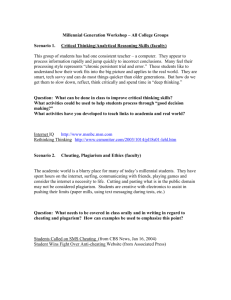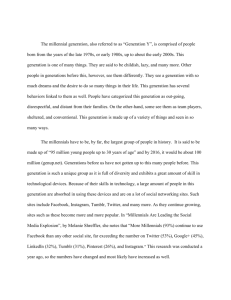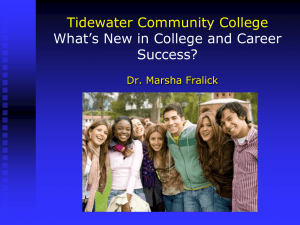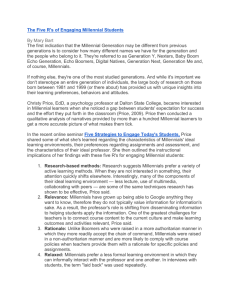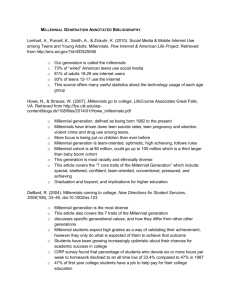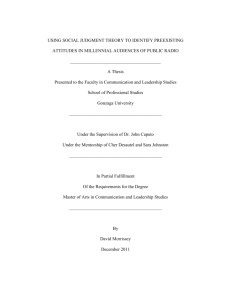handout for millennial faculty workshop
advertisement
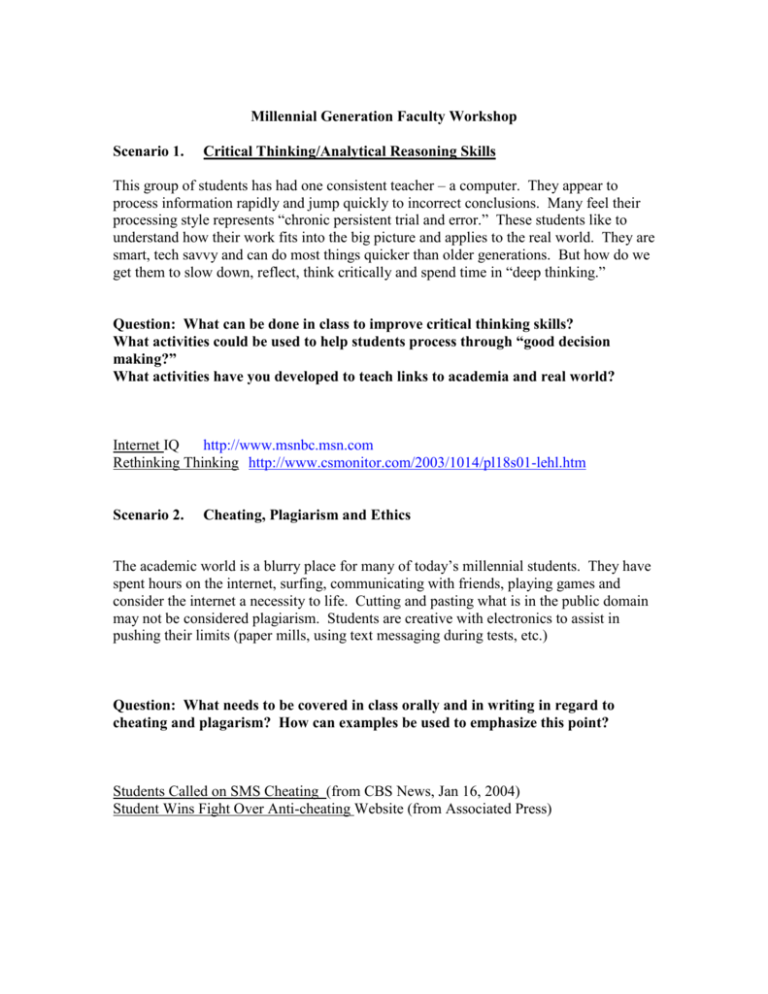
Millennial Generation Faculty Workshop Scenario 1. Critical Thinking/Analytical Reasoning Skills This group of students has had one consistent teacher – a computer. They appear to process information rapidly and jump quickly to incorrect conclusions. Many feel their processing style represents “chronic persistent trial and error.” These students like to understand how their work fits into the big picture and applies to the real world. They are smart, tech savvy and can do most things quicker than older generations. But how do we get them to slow down, reflect, think critically and spend time in “deep thinking.” Question: What can be done in class to improve critical thinking skills? What activities could be used to help students process through “good decision making?” What activities have you developed to teach links to academia and real world? Internet IQ http://www.msnbc.msn.com Rethinking Thinking http://www.csmonitor.com/2003/1014/pl18s01-lehl.htm Scenario 2. Cheating, Plagiarism and Ethics The academic world is a blurry place for many of today’s millennial students. They have spent hours on the internet, surfing, communicating with friends, playing games and consider the internet a necessity to life. Cutting and pasting what is in the public domain may not be considered plagiarism. Students are creative with electronics to assist in pushing their limits (paper mills, using text messaging during tests, etc.) Question: What needs to be covered in class orally and in writing in regard to cheating and plagarism? How can examples be used to emphasize this point? Students Called on SMS Cheating (from CBS News, Jan 16, 2004) Student Wins Fight Over Anti-cheating Website (from Associated Press) Scenario 3. Teaching Millennials Millennial students have come from K-12 systems where faculty are responsible for engaging them in active learning. They are used to faculty who assist learning not control learning. They are sometimes too focused on grades and performance rather than learning. They have worked in groups since they were small and respond well to peer tutoring, supplemental instruction, learning communities, etc. Higher education is so different from what they are used to that many are not succeeding. Question: What kind of assignments and group activities can be done in the classroom to help students succeed? How can class time be structured to keep them on task? How much access should we give them and how much technology is enough? The Net Generation Goes to College http://chronicle.com A’s for Everyone http://www.wachingtonpost.com/wpdyn/contet/article/2005/06/02/AR2005060201593_pf Scenario 4. Class and Institutional Policies Casual communications have led students to abuse email and instant messaging with their faculty. Students call their teachers late at night and want to use cell phones in class. They use electronic “toys” in class and can be very distracting. Faculty are split down the middle on college policies relating to cell phone usage, PDAs, etc. Parents also want to know what is going on at the institution (those with children under 25). Some colleges are creating materials for parents to keep them informed without violating FERPA. Question: What items should be included on the syllabus in regard to class policies about electronics toys, cell phones, etc. for any course? What are the major issues impacting the classroom when it comes to electronic toys/equipment? Should your institution have a communication policy and should that be on the syllabus? What should be your policy in communicating with parents? How can the business office and student services better communicate with students and their families? Why It’s All About Me Hold the Phone (New York Times, February 21, 2006) www.electronic-school.com Scenario 5. Millennials and the workforce. This generation doesn’t live in an 8-5 world and is headed for some disappointment in the workforce. They are not ready for the workforce and the workforce is not ready for them. Millennial faculty will begin showing up to teach at our institutions in the next few years. Businesses are beginning to have trouble retaining Gen X and Gen Y employees who have different expectations. Question: What do we need to know and what should we do in our classes to prepare them for the “world of work?” What realities are they going to face? How can we prepare the workforce for the entrance of 81 million of this generation? Should we begin training programs for business/industry to prepare them for changing values/standards with younger employees? Managing Millennials http://www.generationsatwork.com The Millennial Challenge: Growing a New Generation of Workers (from Vertitude, Strategic Human Resources) http://www.vertitude.com/resourcecenter/resourceview.aspx?id=1349 Scenario 6. Students with special needs Student services is dealing with these students in many ways: low performing ones needing tutoring, low test scores needing remedial, many have various learning disabilities, many have parents who try to control their children. Many of these students show up with various types of learning disabilities and have never had to self-advocate to receive services. Faculty have not necessarily been trained to deal with these students and their issues Questions: What training does your student services area need to offer for faculty to better equip them to teach with the diversity of students we have today? What changes need to be made in student services to better deal with this generation? How do we effectively deal with the parents of this generation? What do “gatekeeper” faculty need to know about remediation? Colleges Ward Off Over-involved Parents (The Wall street Journal Online) Tips for Students with Disabilities to Increase College Success http://www.washington.edu Scenario 7. 1st Generation - Less Prepared Students Many in this generation come from immigrant families. Many are 1st generation or generation 1.5. The generation seems to be split by ability level that has been influenced by technology. Part of the generation does exceptionally well in school and has had educationally enhancing tools at home. Others have had little in the way of educational software and enhancing tools. This group may have had little academic success and many have performed below grade level for years. Questions: What should the college do to better serve lower performing students? How can we decrease the achievement gaps between these students and more traditional students? How do we bring these students up to speed with technology? Defining the Technology Gap http://www.benton.org/library/low-income/one.html Emerging and Persistent Issues for First-year Students http://www.psu.edu/dus/mentor/041022gs.htm Scenario 8. Diversity This is the most racially and ethnically diverse generation in US history. They have been exposed to different races, religions, sexual orientations, generations, languages, holiday traditions, etc. from the time they were very small. They get along with all generations and have open attitudes toward differences in people. Because community college classrooms have students from 15-90 year of age, older generations may not be as accepting of their “liberal attitudes” toward diversity. Questions: How can we help students develop an appreciation for multiple cultures? How can we communicate the importance of generational differences in these student’s’ future work places? How can faculty effectively deal with issues of great diversity in the classroom? A Multidimensional Approach to Faculty Development: Understanding the TeachingLearning Process http://www.diversityweb.org/digest/W99/multidimensional.html Diversity and Complexity in the Classroom http://honolulu.hawaii.edu/intranet/committees/FacDevCom/guidebk/teachtip/diverse.ht m
